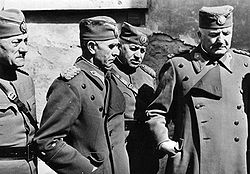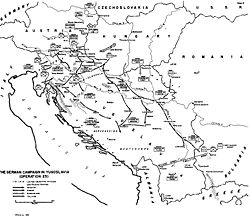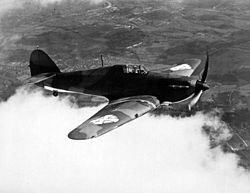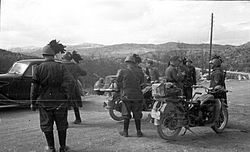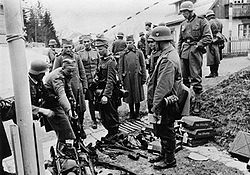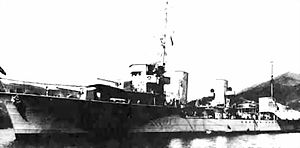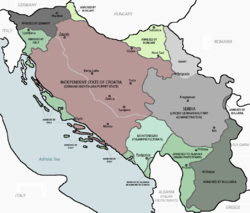- Invasion of Yugoslavia
-
"April War" redirects here. For other uses, see April War (disambiguation).
Invasion of Yugoslavia (Unternehmen 25) Part of the Balkans Campaign of World War II 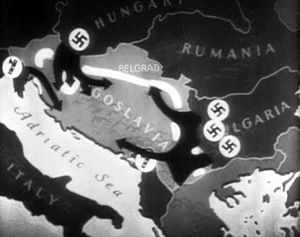
An animation depicting the Axis invasion of Yugoslavia from the Why We Fight series.Date 6 April 1941 – 17 April 1941 Location Yugoslavia Result Decisive Axis victory - Occupation of Yugoslavia
- Partition of Yugoslavia between the Axis
- Creation of pro-Axis puppet regimes
- Beginning of the Yugoslav Front
Belligerents Axis:
Allies:
 Yugoslavia
YugoslaviaCommanders and leaders  Maximilian von Weichs
Maximilian von Weichs
 Wilhelm List
Wilhelm List
 Vittorio Ambrosio
Vittorio Ambrosio
 Elemér Gorondy-Novák
Elemér Gorondy-Novák Dušan Simović
Dušan Simović
 Milorad Petrović
Milorad Petrović
 Milutin Nedić
Milutin Nedić
 Milan Nedić
Milan Nedić
 Petar Nedeljković
Petar Nedeljković
 Vladimir Čukavac
Vladimir Čukavac
 Dimitrije Živković
Dimitrije Živković
 Dušan Trifunović
Dušan TrifunovićStrength 700,000 850,000 Casualties and losses Germany: (Official German WW2 figures) 151 killed
392 wounded
15 missing
60+ aircraft shot down and over 70 aircrew killed or missing.
Italy: 3,324 killed or wounded
10+ aircraft shot down, 22 damaged.
Hungary: 120 killed
223 wounded
13 missing
1+ aircraft shot down.Thousands of civilians and soldiers killed
254,000-345,000 captured by Germans, 30,000 by Italians
49 aircraft shot down, 103 pilots and aircrew killed
211 aircraft captured
3 destroyers and 3 submarines captured.Balkans CampaignThe Invasion of Yugoslavia (code-name Directive 25 or Operation 25), also known as the April War (Croatian: Travanjski rat, Serbian/Bosnian: Aprilski rat, Slovene: aprilska vojna), was the Axis Powers' attack on the Kingdom of Yugoslavia which began on 6 April 1941 during World War II. The invasion ended with the unconditional surrender of the Royal Yugoslav Army on 17 April 1941, annexation and occupation of the region by the Axis powers and the creation of the Independent State of Croatia (Nezavisna Država Hrvatska, or NDH).
Contents
Background
In October 1940, Fascist Italy had attacked Greece only to be forced back into Albania. German dictator Adolf Hitler recognised the need to go to the aid of his ally, Italian dictator Benito Mussolini. Hitler did this not only to restore diminished Axis prestige, but also to prevent the United Kingdom from being able to bomb the Romanian oilfields from which Germany obtained most of her oil.[1]
Following agreements with Hungary, Romania and Bulgaria that they would join the Axis, Hitler put pressure on Yugoslavia to join the Tripartite Pact. The Regent, Prince Paul of Yugoslavia, succumbed to this pressure on 25 March 1941. However, this move was deeply unpopular amongst the anti-Axis Serbian public and military. A coup d'état was launched on 27 March 1941 by anti-Paul Serbian military officers, and the Regent was replaced on the throne by King Peter II of Yugoslavia.[2]
Upon hearing news of the coup in Yugoslavia, Hitler called his military advisers to Berlin on 27 March. Hitler took the coup as a personal insult, and was so angered that he was determined "without waiting for possible declarations of loyalty of the new government to destroy Yugoslavia militarily and as a nation.",[3] despite the apparent readiness of the new Yugoslav rulers to maintain Yugoslavia's involvement in the Tripartite Pact.[4]
The Royal Yugoslav Armed Forces
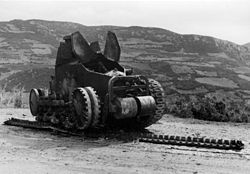 Destroyed Yugoslavian FT-17 tank.
Destroyed Yugoslavian FT-17 tank.
Equipment and organization
 Yugoslav designed and built Rogozarski IK-3 fighter aircraft, in camouflage colors at the end of 1940. This particular aircraft was flown by Eduard Banfić on 6 and 7 April 1941 in the air battle for the defense of Belgrade. Banfić was credited with shooting down 2 confirmed and one probable German aircraft during this period.
Yugoslav designed and built Rogozarski IK-3 fighter aircraft, in camouflage colors at the end of 1940. This particular aircraft was flown by Eduard Banfić on 6 and 7 April 1941 in the air battle for the defense of Belgrade. Banfić was credited with shooting down 2 confirmed and one probable German aircraft during this period.
Formed after World War I, the Royal Yugoslav Army was still largely equipped with weapons and material from that era, although some modernization with Czech equipment and vehicles had begun. Of about 4,000 artillery pieces, many were aged and horse-drawn, but about 1,700 were relatively modern, including 812 Czech 37mm and 47mm anti-tank guns. There were also about 2,300 mortars, including 1600 modern 81mm pieces, as well as twenty four 220 and 305mm pieces. Of 940 anti-aircraft guns, 360 were 15 and 20mm Czech and Italian models. All of these arms were imported, from different sources, which meant that the various models often lacked proper repair and maintenance facilities.[5] The only mechanized units were six motorized infantry battalions in the three cavalry divisions, six motorized artillery regiments, two tank battalions equipped with one-hundred-and-ten tanks, one of which had Renault FT-17s models of First World War origin and the other fifty-four modern French Renault R35 tanks, plus an independent tank company with eight Czech SI-D tank destroyers. Some one-thousand trucks for military purposes had been imported from the United States of America in the months just preceding the invasion.[6]
Fully mobilized, the Royal Yugoslav Army could have put 28 infantry divisions, 3 cavalry divisions, and 35 independent regiments in the field. An independent parachute unit, of company size, was formed in late 1939, but was not yet combat-ready.[7] Of the independent regiments, 16 were in frontier fortifications and 19 were organized as combined regiments, or "Odred", around the size of a reinforced brigade. Each Odred had one to three infantry regiments and one to three artillery battalions, with three organised as "alpine" units. The German attack, however, caught the army still mobilizing, and only some 11 divisions were in their planned defense positions at the start of the invasion. The units were filled to between 70 and 90 percent of their strength as mobilization was not completed. The strength of the Royal Yugoslav Army was about 1,200,000 as the German invasion got underway.[8]
The Royal Yugoslav Air Force had over 450 front-line aircraft of domestic (notably the IK-3), German, Italian, French, and British origin, of which more than half were modern types. Organized into twenty-two bomber squadrons and nineteen fighter squadrons, the main aircraft types in operational use included seventy-three Messerschmitt Bf 109 E, thirty-eight Hawker Hurricane I (with more being built under licence in Yugoslavia), thirty Hawker Fury II, eight Ikarus IK-2, and six Rogozarski IK3 fighters (plus more under construction), sixty-three Dornier Do 17 K (including 40 plus licence built), sixty Bristol Blenheim I (including some 40 licence built) and forty Savoia Marchetti SM-79 K bombers. The Naval Aviation units comprised 8 squadrons equipped with, amongst other auxiliary types, twelve Dornier Do 22 K and fifteen Rogozarski SIM-XIV-H locally designed and built maritime patrol float-planes.
The aircraft of the Yugoslav airline Aeroput, consisting mainly of six Lockheed Model 10 Electras, three Spartan Cruisers, and one de Havilland Dragon were mobilised to provide transport services to the Air Force.[9]
The Royal Yugoslav Navy was equipped with one elderly ex-German light cruiser (suitable only for training purposes), 1 large modern destroyer flotilla leader of British design, 3 modern destroyers of French design (2 built in Yugoslavia plus another still under construction), 1 seaplane tender, 4 modern submarines (2 older French-built and 2 British-built) and 10 modern motor torpedo boats (MTBs), of the older vessels, there were 6 ex-Austrian Navy medium torpedo boats, 6 mine-layers, 4 large armoured river monitors and various auxiliary craft.[10]
Deployment
The Yugoslav Army had purchased 54 R35 Tanks from France in the late 1930s, seen here taking part in manoeuvres in 1940.
The Royal Yugoslav Army was organized into three army groups and the coastal defense troops. The 3rd Army Group was the strongest with the 3rd, 3rd Territorial, 5th and 6th Armies defending the borders with Romania, Bulgaria and Albania. The 2nd Army Group with the 1st and 2nd Armies, defended the region between the Iron Gates and the Drava River. The 1st Army Group with the 4th and 7th Armies, composed mainly of Croatian troops, was in Croatia and Slovenia defending the Italian, German (Austrian) and Hungarian frontiers.[6][11]
The strength of each "Army" amounted to little more than a corps, with the 3 Army Groups consisting of the units deployed as follows; The 3rd Army Group's 3rd Army consisted of 4 infantry divisions and one cavalry odred; the 3rd Territorial Army with 3 infantry divisions and one independent motorized artillery regiment; the 5th Army with 4 infantry divisions, 1 cavalry division, 2 odred and one independent motorized artillery regiment and the 6th Army with 3 infantry divisions, the 2 Royal Guards brigades (odred) and 3 infantry odred. The 2nd Army Group's 1st Army had 1 infantry and 1 cavalry divisions, 3 odred and 6 frontier defence regiments; the 2nd Army had 3 infantry divisions and 1 frontier defence regiment. Finally, the 1st Army Group consisted of the 4th Army, with 3 infantry divisions and one odred, whilst the 7th Army had 2 infantry divisions, 1 cavalry division, 3 mountain odred, 2 infantry odred and 9 frontier defence regiments. The Strategic, "Supreme Command" Reserve in Bosnia comprised 4 infantry divisions, 4 independent infantry regiments, 1 tank battalion, 2 motorized engineer battalions, 2 motorized heavy artillery regiments, 15 independent artillery battalions and 2 independent anti-aircraft artillery battalions. The Coastal Defence Force, on the Adriatic opposite Zadar comprised 1 infantry division and 2 odred, in addition to fortress brigades and anti-aircraft units at Šibenik and Kotor.[12]
On the eve of invasion, clothing and footwear were available for only two-thirds or so of the potential front-line troops and only partially for other troops; some other essential supplies were available for only a third of the front-line troops; medical and sanitary supplies were available for only a few weeks, and supplies of food for men and feed for livestock were available for only about two months. In all cases there was little or no possibility of replenishment.[13]
Beyond the problems of inadequate equipment and incomplete mobilization, the Royal Yugoslav Army suffered badly from the Serbo-Croat schism in Yugoslav politics. "Yugoslav" resistance to the invasion collapsed overnight. The main reason was that none of the subordinate national groups; Slovenes, Croats were prepared to fight in defence of a Serbian Yugoslavia. Also, so that the Slovenes did not feel abandoned, defences were built on Yugoslavia's northern border when the natural line of defence was much further south, based on the rivers Sava and Drina. The only effective opposition to the invasion was from wholly Serbian units within the borders of Serbia itself.[14] The Germans, thrusting north-west from Skoplje, were held up at Kacanik Pass and lost several tanks (P39, Buckley C "Greece and Crete 1941" HMSO 1977). In its worst expression, Yugoslavia's defenses were badly compromised on April 10, 1941, when some of the units in the Croatian-manned 4th and 7th Armies mutinied, and a newly formed Croatian government hailed the entry of the Germans into Zagreb the same day.[15] The Serbian General Staff were united on the question of Yugoslavia as a "Greater Serbia", ruled, in one way or another, by Serbia. On the eve of the invasion, there were 165 generals on the Yugoslav active list. Of these, all but four were Serbs.[16]
Operations
Starting on 6 April 1941, Axis armies invaded from all sides and the German Air Force (Luftwaffe) bombed Belgrade. German armies were the first to cross the border with Hungarian and Italian armies following a few days later. Tsar Boris III avoided committing Bulgarian troops to the invasion by claiming that all of his battle worthy troops were guarding the flank of Germany's 12th Army against Turkey.[17] In a similar manner, while Romania was a staging area for German forces, no Romanian troops were committed to the invasion.
The bombing of Belgrade
Luftflotte 4 of the German Air Force (Luftwaffe), with a strength of seven Combat Formations (Kampfgruppen) had been committed to the campaign in the Balkans.[18] Hitler, infuriated at Yugoslavia's defiance, ordered the implementation of Operation Punishment (Unternehmen Strafgericht). At 7 am on 6 April the Luftwaffe opened the assault on Yugoslavia by conducting a saturation-type bombing raid on the capital. Flying in relays from airfields in Austria and Romania, 300 aircraft, of which a quarter were Junkers Ju 87 Stukas, protected by a heavy fighter escort began the attack.[19] The dive-bombers were to silence the Yugoslav anti-aircraft defences while the medium bombers consisting mainly Dornier Do 17 and Junkers Ju 88 attacked the city. The initial raid was carried out at fifteen-minute intervals in three distinct waves, each lasting for approximately twenty minutes. Thus, the city was subjected to a rain of bombs for almost one and a half hours. The German bombers directed their main effort against the center of the city, where the principal government buildings were located. The medium bomber Kampfgruppen continued their attack on the city for several days while the Stuka dive bomber wings (Stukageschwaders) were soon diverted to Yugoslav airfields.
When the attack was over, some 4,000 inhabitants lay dead under the debris. This blow virtually destroyed all means of communication between the Yugoslav high command and the forces in the field, although most of the elements of the general staff managed to escape to one of the suburbs.
Having thus delivered the knockout blow to the enemy nerve center, the Luftwaffe was able to devote its maximum effort to military targets such as Yugoslav airfields, routes of communication, and troop concentrations, and to the close support of German ground operations.
The Yugoslav Air Force put up its Belgrade defence interceptors from the six squadrons of the 32nd and 51st Fighter Groups to attack each wave of bombers, although as the day wore on the four squadrons from the 31st and 52nd Fighter Groups, based in central Serbia, also took part. The Messerschmitt 109E, Hawker Hurricane Is and Rogozarski IK-3 fighters scored at least twenty "kills" amongst the attacking bombers and their escorting fighters on 6 April and a further dozen shot down on 7 April. The desperate defence by the Yugoslav Air Force over Belgrade cost it some 20 fighters shot down and 15 damaged.[20]
The Air Battle
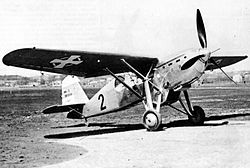 The Ikarus IK-2 was a Yugoslav-designed and built fighter aircraft which entered service in the late 1930s. One squadron of 8 aircraft was based in Bosnia at the time of the invasion, mixing it with Luftwaffe Messerschmitt Bf 109s. Four captured examples were subsequently used by the Air Force of the Independent State of Croatia.
The Ikarus IK-2 was a Yugoslav-designed and built fighter aircraft which entered service in the late 1930s. One squadron of 8 aircraft was based in Bosnia at the time of the invasion, mixing it with Luftwaffe Messerschmitt Bf 109s. Four captured examples were subsequently used by the Air Force of the Independent State of Croatia.
Following the Belgrade Coup on 25 March 1941, the Yugoslav armed forces were put on alert, although the army was not fully mobilised for fear of provoking Hitler. The Royal Yugoslav Air Force (JKRV) command decided to disperse its forces away from their main bases to a system of 50 auxiliary airfields that had previously been prepared. However many of these airfields lacked facilities and had inadequate drainage which prevented the continued operation of all but the very lightest aircraft in the adverse weather conditions encountered in April 1941.[21]
Despite having superior aircraft to some of the previously German-occupied eastern European nations such as Poland or Czechoslovakia, the JKRV could simply not match the overwhelming Luftwaffe and Regia Aeronautica superiority in terms of numbers, tactical deployment and combat experience. As a result, the 11 day fight put up by the JKRV was nothing short of extraordinary.[citation needed]
The bomber and maritime force hit targets in Italy, Germany (Austria), Hungary, Romania, Bulgaria, Albania and Greece, as well as attacking German, Italian and Hungarian troops. Meanwhile the fighter squadrons inflicted not insignificant losses on escorted Luftwaffe bomber raids on Belgrade and Serbia, as well as upon Regia Aeronautica raids on Dalmatia, Bosnia, Herzegovina and Montenegro. The JKRV also provided direct air support to the hard pressed Yugoslav Army by strafing attacking troop and mechanized columns in Croatia, Bosnia and Serbia (sometimes taking off and strafing the troops attacking the very base being evacuated).[22]
Little wonder then that after a combination of air combat losses, losses on the ground to enemy air attack on bases and the overrunning of airfields by enemy troops, that after 11 days the JKRV almost ceased to exist. It must, however, be noted that between 6 and 17 April 1941 the JKRV received an additional 8 Hawker Hurricane Is, 6 Dornier Do-17Ks, 4 Bristol Blenheim Is, 2 Ikarus IK 2s, 1 Rogozarski IK-3 and 1 Messerschmitt Bf 109 from the local aeronautical industry's aircraft factories and work-shops.[23]
The JKRV's Dornier bomber force provides an illustrative case in point. At the beginning of the April war, the Royal Yugoslav Air Force was armed with some 60 German designed Dornier Do 17Ks, purchased by Yugoslavia in the autumn of 1938, together with a manufacturing licence. The sole operator was 3 vazduhoplovni puk (3rd bomber regiment) composed of two bomber groups; the 63rd Bomber Group stationed at Petrovec airfield near Skopje and the 64th Bomber Group stationed at Milesevo airfield near Priština. Other auxiliary airfields had also been prepared to aid in dispersal.[22]
During the course of hostilities, the State Aircraft Factory in Kraljevo managed to produce six more aircraft of this type. Of the final three, two were delivered to the JKRV on 10 April and one was delivered on 12 April 1941.
On 6 April, Luftwaffe dive-bombers and ground-attack fighters destroyed 26 of the Yugoslav Dorniers in the initial assault on their airfields, but the remaining aircraft were able to effectively hit back with numerous multi-ship attacks on German mechanized columns and upon Bulgarian airfields.[24] By the end of the campaign total Yugoslav losses stood at four destroyed in aerial combat and 45 destroyed on the ground.[25] Between 14th and 15 April, the seven remaining Do 17K flew to Nikšić airfield in Montenegro and took part in the evacuation of King Petar II and members of the Yugoslav government to Greece. During this operation, Yugoslav gold reserves were also airlifted to Greece by the seven Do 17s,[25] as well as by Savoia Marchetti SM-79Ks and Aeroput Lockheed Model 10 Electras but after completing their mission, five Do 17K were destroyed on the ground when Italian aircraft attacked the Greek-held Paramitia airfield. Only two Do 17Ks escaped destruction in Greece and later joined the British Royal Air Force (RAF) in the Kingdom of Egypt.
At 16:00 on the 15 April the C-in-C of Luftflotte 4, Generaloberst Alexander Löhr received orders from Hermann Göring to wind down the air-offensive and transfer the bulk of the dive-bomber force to support the campaign in Greece.[26]
A total of 18 bomber, transport and maritime patrol aircraft (2 Dornier Do 17K, 4 Savoia Marchetti SM-79K, 3 Aeroput Lockheed Model 10 Electra, 8 Dornier Do-22K and 1 Rogozarski SIM-XIV-H) succeeded in escaping to the Allied base in Egypt at the end of the campaign.[9]
The Three-Pronged Drive on the Yugoslav Capital
 German Panzer IV of the 11th Panzer Division advancing into Yugoslavia from Bulgaria as part of the Twelfth Army.
German Panzer IV of the 11th Panzer Division advancing into Yugoslavia from Bulgaria as part of the Twelfth Army.
The British, Greek and Yugoslav high commands intended to use Niš as the lynch-pin in their attempts to wear down German forces in the Balkans and it is for this reason that the locality was important. The Yugoslav Supreme Command committed its reserves, including the 2nd Cavalry Division, but these were harassed by the German Air Force (Luftwaffe) during transit to the front.[8]
The fall of Belgrade
Italian and Hungarian offensive actions
The Italian Second Army crossed the border soon after the Germans. The Second Army faced the Yugoslavian Seventh Army. The Italians encountered limited resistance and occupied parts of Slovenia, Croatia, and the coast of Dalmatia. In addition to the Second Army, Italy had four divisions of the Ninth Army on the Yugoslavian border with Albania. These units defended against a Yugoslav offensive on that front. Around 300 Ustaše volunteers under the command of Ante Pavelić accompanied the Italian Second Army during the invasion; about the same number of Ustaše came with the German Army and other Axis allies.[27]
On 12 April the Hungarian Third Army crossed the border with one cavalry, two motorized and six infantry brigades. The Third Army faced the Yugoslavian First Army. By the time the Hungarians crossed the border, the Germans had been attacking Yugoslavia for over a week. As a result, the Yugoslavian forces confronting them put up little resistance, except for the units in the frontier fortifications, who had held up the Hungarian advance for some time.[8] and inflicted some 350 casualties.[28] Units of the Hungarian Third Army advanced into a triangular shaped area between the Danube River and the Drava River, and occupied the Bačka region in Vojvodina with Hungarian relative majority. The Hungarian forces occupied only those territories which were part of Hungary before the Treaty of Trianon. Showing his disagreement with the Hungarian operations, prime minister Pál Teleki committed suicide.
Yugoslav Albanian offensive
In accordance with the Royal Yugoslav Army's war plan, R-41, a strategy was formulated that, in the face of a massive Axis attack, a retreat on all fronts except in the south be performed. Here the 3rd Yugoslav Army, in cooperation with the Greek Army, was to launch an offensive against the Italian forces in Albania. This was in order to secure space to enable the withdrawal of the main Yugoslav Army to the south. This would be via Albanian territory in order to reach Greece and the Allied forces to be based there. The strategy was based on the premise that the Yugoslav Army would, together with the Greek and British Armies, form a new version of the Salonika Front of World War I.[29]
The 3rd Yugoslav Army of the 3rd Army Group was tasked with conducting offensive operations against the Italian army in northern Albania. For this purpose the 3rd Army had concentrated four infantry divisions and one combined regiment (Odred) in the Montenegro and Kosovo regions: - 15th Infantry Division "Zetska" - 13th Infantry Division "Hercegovacka" - 31st Infantry Division "Kosovska" - 25th Infantry Division "Vardarska" - "Komski" cavalry Odred.
The strategic reserve of the 3rd Army Group, the 22nd Infantry Division "Ibarska", was situated around Uroševac in the Kosovo region.
In addition, offensive operations against the Italian enclave of Zara (Zadar) on the Dalmatian coast were to be undertaken by the 12th Infantry Division "Jadranska".
The first elements of the 3rd Army launched their offensive operations in North Albania on 7 April 1941, with the Komski Odred covering the Gusinje-Prokletije mountains area advancing towards the village of Raja-Puka. The Kosovska Division crossed the border in the Prizren area of Kosovo and was advancing through the Drin River valley. The Vardarska Division gained some local success at Debar, while the rest of the army's units were still assembling.
The next day, the 8th, found the Zetska Division steadily advancing along the Podgorica–Shkodër road. The Komski cavalry Odred successfully crossed the dangerous Prokletije mountains and reached the village of Koljegcava in the Valjbone River Valley. South of them the Kosovska Division broke through the Italian defences in the Drin River Valley, but due to the fall of Skopje to the attacks by the German Army, the Vardarska Division was forced to stop its operations in Albania.[8]
The 9 April 1941 saw little further progress for the Yugoslavs, because although the Zetska Division continued advancing towards Shkodër and the Komski Odred reached the Drin River, the Kosovska Division had to halt all combat activities on the Albanian Front due to the appearance of German troops in Prizren.
On 10 April 1941 the Zetska Division was still steadily fighting its way towards Shkodër and had advanced 50 km in some places. These advances had been supported by aircraft of the Yugoslav Royal Air Force's 66th and 81st Bomber Groups, who attacked airfields and Italian troop concentrations around Shkodër, as well as the port of Durrës.[30]
The Komski Odred and the right column of the Kosovska Division advanced along the right bank of the Drin River towards Shkodër in order to link with Zetska Division, but the central and left column of the Kosovska Division were forced to take a defensive perimeter to hold off the increasing pressure by German troops.
Between 11–13 April 1941, with German and Italian troops advancing on its rear areas, the Zetska Division was forced to retreat back to the Pronisat River by the Italian 131st Centauro Armoured Division, where it remained until the end of the campaign on the 16th of April. The Centauro Division then advanced upon the Yugoslav fleet base of Kotor in Montenegro.[8]
 Yugoslav destroyer Beograd. Of 1,210 tons, she was armed with 4x4.7 inch guns and 4x40mm A.A guns, as well as 6x533mm torpedo tubes. The "Beograd" was damaged by near misses from Italian aircraft off Šibenik during the April campaign.
Yugoslav destroyer Beograd. Of 1,210 tons, she was armed with 4x4.7 inch guns and 4x40mm A.A guns, as well as 6x533mm torpedo tubes. The "Beograd" was damaged by near misses from Italian aircraft off Šibenik during the April campaign.
When Germany and Italy attacked Yugoslavia on 6 April 1941, The Yugoslav Royal Navy had available 3 destroyers, 2 submarines and 10 MTBs as the most effective units of the fleet. One other destroyer, the "Ljubljana" was in dry-dock at the time of the invasion and she and her anti-aircraft guns were used in defence of the fleet base at Kotor. The remainder of the fleet was useful only for coastal defence and local escort and patrol work.
Kotor was close to the Albanian border and the Italo-Greek front there, but Zara (Zadar), an Italian enclave, was to the north-west of the coast and to prevent a bridgehead being established, the destroyer "Beograd", 4 of the old torpedo boats and 6 MTBs were despatched to Šibenik, 80 km to the south of Zara, in preparation for an attack. The attack was to be co-ordinated with the 12th "Jadranska" Infantry Division and two "Odred" (combined regiments) of the Royal Yugoslav Army attacking from the Benkovac area, supported by air attacks by the 81st Bomber Group of the Royal Yugoslav Air Force. The Yugoslav forces launched their attack on 9 April but by 13 April the Italian forces had counter-attacked and were in Benkovac by 14 April.[8] The naval prong to this attack faltered when the destroyer "Beograd" was damaged by near misses from Italian aircraft off Šibenik when her starboard engine was put out of action, after which she limped to Kotor, escorted by the remainder of the force, for repair.[31]
The maritime patrol float-planes of the Royal Yugoslav Air Force flew reconnaissance and attack missions during the campaign, as well as providing air cover for mine-laying operations off Zara (Zadar). Some of their successes included an Italian tanker being damaged by a near miss off the Italian coast near Bari, attacks on the Albanian port of Durrës, as well as strikes against Italian re-supply convoys to Albania. On 9 April, one Dornier Do 22K floatplane notably took on an Italian convoy of 12 steamers with an escort of 8 destroyers crossing the Adriatic during the day, attacking single-handed in the face of intense AA fire.[32]
The Royal Yugoslav Navy also had at its disposal four large, heavily armed and armoured river monitors in its riverine flotilla. They were used to patrol the Danube, Drava and Sava rivers in the northern parts of Yugoslavia and its border with Hungary. These monitors, the Drava, Sava, Morava and Vardar had been inherited from the Austrian Navy at the end of World War I. All were of around 400-500t with a main armament of two 120 mm guns, two or three 66 mm guns, 120 mm mortars, 40 mm AA guns and machine guns. At the start of the campaign they had carried out offensive operations by shelling the airfield at Mohács in Hungary on the 6th of April and again two days later, but had to begin withdrawing towards Novi Sad by the 11th of April after coming under repeated attack by German dive-bombers. Early in the morning of 12 April, a squadron of German Junkers Ju 87 dive-bombers attacked the Yugoslav monitors on the Danube. The "Drava", commanded by Aleksandar Berić,[33] was hit by several of them but they were unable to penetrate the "Drava's" 300 mm thick deck armour, until, by chance, one put a bomb straight down the funnel, killing 54 of the 67 man crew. During the attack anti-aircraft gunners on the monitors claimed 3 dive-bombers shot down. The remaining 3 monitors were scuttled by their crews later on 12 April as German and Hungarian forces had occupied the bases and the river systems upon which they operated.[34]
Losses
 A destroyed Yugoslav Renault FT-17 or NC-27 tank
A destroyed Yugoslav Renault FT-17 or NC-27 tank
The losses sustained by the German attack forces were unexpectedly light. During the twelve days of combat the total casualty figures came to 558 men: 151 were listed as killed, 392 as wounded, and 15 as missing in action. During the XLI Panzer Corps drive on Belgrade, for example, the only officer killed in action fell victim to a civilian sniper's bullet. The Luftwaffe lost approximately 60 aircraft shot down over Yugoslavia, costing the lives of at least 70 aircrew. The Italian Army took heavy casualties in northern Albania from the Yugoslav offensive there,[8] whilst the Italian Air Force lost approximately 10 aircraft shot down, with a further 22 damaged. The Hungarian Army suffered some 350 casualties (120 killed, 223 wounded and 13 missing in action) from the shelling by Yugoslav riverine forces of its frontier installations and in its attacks upon the Yugoslav frontier forces in Vojvodina,[28] with one quarter of a Hungarian parachute 'battalion' becoming casualties when a transport aircraft filled with 30 troops went down during an abortive drop on 12 April.[35]
The Germans took between 254,000 and 345,000 Yugoslav prisoners, excluding a considerable number of ethnic Croat, German and Hungarian who had been conscripted into the Yugoslav Army and who were quickly released after screening, and Italians took 30,000 more.[36][37]
Approximately 1,000 army and several hundred air force personnel (including one mobile-workshop unit of six vehicles) escaped via Greece to Egypt.[38]
In their brief fight, the Royal Yugoslav Air Force suffered the loss of 49 aircraft to Axis fighters and anti-aircraft fire, with many more damaged beyond repair. These losses had cost the lives of 27 fighter pilots and 76 bomber aircrew. 85 more aircraft had been destroyed on the ground by air attack, while many others had been destroyed or disabled by their own crews, or had crashed during operations, or in evacuation flights.
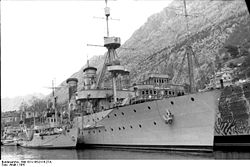 Yugoslav Navy ships captured by the Italian Regia Marina in April 1941. They are, from left, a Malinska-class mine-layer, the light cruiser Dalmacija and the submarine depot ship Hvar.
Yugoslav Navy ships captured by the Italian Regia Marina in April 1941. They are, from left, a Malinska-class mine-layer, the light cruiser Dalmacija and the submarine depot ship Hvar.
Despite these losses, more than 70 Yugoslav aircraft escaped to Allied territory, mostly to Greece, but 8 Dornier and Savoia Marchetti bombers set course for the USSR, with 4 making it safely. Several dozen of the escapee aircraft were destroyed in a devastating strafing attack by the Italian air force on Paramitia airfield in Greece, with 9 bombers and transports making it to Egypt. More than 300 operational, auxiliary and training aircraft were captured and passed on to the newly created Air Force of the Independent State of Croatia,[39] Finland, Romania and Bulgaria.
The Italians captured most of the Yugoslav Navy (one of its 4 destroyers, the "Ljubljana", had spent the campaign in dry-dock).[31] However, another destroyer, the "Zagreb", was blown up at Kotor by two of its officers to prevent capture and one of the British-built submarines and 2 MTBs succeeded in escaping to Alexandria in Egypt to continue to serve with the Allied cause.[10] It should also be noted that a fourth destroyer was captured while under construction in the Kotor shipyard, the "Split", but the Regia Marina was not able to finish her before the armistice in 1943. Eventually, she was recovered after the war by the Yugoslavians and completed under the original name.[40] 10 Yugoslav Navy maritime patrol float-planes escaped to Greece, with 9 making it to Egypt, where they formed a squadron under RAF command.
Aftermath
The Axis victory was swift. On 17 April 1941, Yugoslavia surrendered after only eleven days. The insistence of the Yugoslav Army on trying to defend all the borders did not help matters. Yugoslavia was subsequently divided amongst Germany, Hungary, Italy and Bulgaria, with most of Serbia being occupied by Germany. The Italian-backed Croatian fascist leader Ante Pavelić declared an Independent State of Croatia [41] before the invasion was even over.
Note
This article incorporates whole sections of text from the U.S. Government work The German Campaign in the Balkans (Spring 1941), United States Army Center of Military History Publication 104-4, 1986.
See also
- Adriatic Campaign of World War II
- Bombing of Belgrade in World War II
- Independent State of Croatia
- Yugoslav Partisans
- Royal Yugoslav Army
- Royal Yugoslav Air Force
- Serbia (1941–1944)
- River Flotilla of Serbian Armed Forces
- Greco-Italian War
- Yugoslav Royal Navy
- Second League of Prizren
References
Notes
- ^ Young, Peter; World War II, Pg 68
- ^ Williams, Heather; Parachutes, Patriots and Partisans: The Special Operations Executive and Yugoslavia, 1941-1945, pp 28-36; C. Hurst & Co., 2003; ISBN 1-85065-592-8
- ^ Shirer, William L., The Rise and Fall of the Third Reich: A History of Nazi Germany, Simon and Schuster, 1990 ISBN 0-671-72868-7, page 824
- ^ Williams, Heather; Parachutes, Patriots and Partisans: The Special Operations Executive and Yugoslavia, 1941-1945, p 33; C. Hurst & Co., 2003; ISBN 1-85065-592-8
- ^ Tomasevich, 1975, p. 58.
- ^ a b Tomasevich, 1975, p. 59.
- ^ Novak et al., 1998, p. 15.
- ^ a b c d e f g Fatutta, et al., 1975.
- ^ a b Shores, et al., 1987, p. 260.
- ^ a b Conways, 1980.
- ^ Geschichte, pp. 317-318
- ^ Fatutta, et al., 1975. p.52.
- ^ Tomasevich, 1975, p. 61.
- ^ Shaw, 1973, p.92
- ^ Times Atlas, p.54
- ^ Shaw, 1973, p.89
- ^ Thomas, 1995, p. 24.
- ^ Goss 2005, p. 89.
- ^ Weal, 1998 p. 25.
- ^ Shores, et al., 1987, p. 200.
- ^ Shores, et al., 1987, p. 174.
- ^ a b Shores, et al., 1987.
- ^ Savic, et al., 2002, p. 8.
- ^ Ciglic, et al., 2007. pp. 32-38.
- ^ a b Goss 2005, p. 10.
- ^ Weal, 1998 p. 29.
- ^ Goldstein, Ivo (1999). Croatia: a history. McGill-Queen's University Press. pp. 131–134. ISBN 0773520171.
- ^ a b Niehorster, 1998, p. 66.
- ^ Tomasevich, 1975, p. 57.
- ^ Shores, et al., 1987, p. 213.
- ^ a b Whitely, 2001, p. 312.
- ^ Shores, et al., 1987, p. 218.
- ^ Krleža, Miroslav; Vladislav Brajković, Petar Mardešić (1972). Pomorska enciklopedija, Volume 2. Jugoslavenski leksikografski zavod. p. 240.
- ^ Shores, et al., 1987, p. 224.
- ^ Shores, et al., 1987, p. 222.
- ^ US Govt History, p. 64
- ^ Geschichte, p. 325
- ^ Ciglic, et al., 2007, p. 32.
- ^ Shores, et al., 1987, p. 310.
- ^ Whitely, 2001, p. 313.
- ^ Tomasevich, 2001, pp. 52-53.
Bibliography
- The German Campaigns in the Balakans (Spring 1941). United States Army Center of Military History. 1986 [1953]. CMH Pub 104-4. http://www.history.army.mil/books/wwii/balkan/intro.htm.
- Ciglic, B. and Savic, D., Dornier Do 17 The Yugoslav Story, Operational Record 1937-1947, Jeroplan, Belgrade, 2007. ISBN 978-86-909727-0-8
- Conways All The World's Fighting Ships 1922-1946, - Conway Maritime Press, London,1980. ISBN 0 85177 146 7
- Fatutta, F. and Covelli, L. 1941: Attack on Yugoslavia, in The International Magazine of Armies & Weapons, Year IV - Nos. 15 and 17, January and May 1975, Lugano, Switzerland.
- Geschichte des Zweiten Weltkrieges Vol. 3, A. A. Gretschko, Berlin: Militärverlag der Deutschen Demokratischen Republik, 1977.
- Goss, Chris. Dornier 17: In Focus, Surrey, UK: Red Kite Books, 2005. ISBN 0-9546201-4-3
- Niehorster, Leo W.G. The Royal Hungarian Army, 1920-1945, Europa Books Bayside New York 1998 ISBN 978-1-891227-19-6
- Novak, J. and Spencer, D., Hrvatski Orlovi: Paratroopers of the Independent State of Croatia 1942-1945, Axis Europa Books, Bayside NY, 1998. ISBN 1 891227 13 0
- Shaw, L., Trial by Slander: A background to the Independent State of Croatia, Harp Books, Canberra, 1973. ISBN 0-909432-00-7
- Shores, C., Cull, B. and Malizia, N., Air War for Yugoslavia, Greece & Crete – 1940-41, Grub Street, London, 1987. ISBN 0-948817-07-0
- The Times Atlas of the Second World War, John Keegan (ed.), New York: Harper and Row, 1989.
- Thomas, N., and Mikulan, K., Axis Forces in Yugoslavia 1941-45, Osprey Publications, 1995. ISBN 1-85532-473-3
- Tomasevich, Jozo. War and Revolution in Yugoslavia 1941-1945: The Chetniks, Stanford, Cal., London, Oxford University Press, 1975. ISBN 0-8047-0857-6
- Tomasevich, Jozo. War and Revolution in Yugoslavia 1941-1945: Occupation and Collaboration, Stanford, Cal.: Stanford University Press, 2001. ISBN 0-8047-3615-4
- United States Army Center of Military History Publication 104-4 The German Campaign in the Balkans (Spring 1941), 1986.
- Weal, John (1998). Junkers Ju 87 Stukageschwader of North Africa and the Mediterranean, Oxford: Osprey. ISBN 1-85532-722-8
- Whitely, M.J., Destroyers of World War Two: An International Encyclopedia, US Naval Institute Press, 2001. ISBN 978-0-87021-326-7
Further reading
- History The German Campaigns in the Balkans (Spring 1941). United States Army Center of Military History. 1986 [1953]. CMH Pub 104-4. http://www.history.army.mil/books/wwii/balkan/intro.htm History.
External links
- Yugoslav Army, April 1941
- Yugoslav Royal Army (Serbian)
- March 27, 1941 (Serbian)
- Invasion of Yugoslavia (Serbian)
- The bombing of Belgrade (Serbian)
- Invasion of Yugoslavia:Kosovo war 1941 (Serbian)
- (Italian) ANPI Archives photos
Yugoslav Front Overview Participants People 1941:
- Military coup
- Invasion of Yugoslavia
- Battle of Loznica
- First Offensive
- Operation Mihailović
1942:
1943:
- Battle of the Neretva (Fourth Offensive)
- Battle of the Sutjeska (Fifth Offensive)
1944:
- Sixth Offensive
- Raid on Drvar (Seventh Offensive)
- Operation Halyard
- Belgrade Offensive
- Kosovo Operation
1945:
- Syrmian Front
- Battle on Lijevča field
- Bar massacre
- Battle of Poljana
Macedonia:
Strategic bombing:
 Partisans
Partisans
 People's Liberation Army of Macedonia (Partisan faction in Macedonia)
People's Liberation Army of Macedonia (Partisan faction in Macedonia)
 Soviet Union (limited involvement, 1944-45)
Soviet Union (limited involvement, 1944-45) Bulgaria (limited involvement, 1944-45)
Bulgaria (limited involvement, 1944-45) National Liberation Movement (limited involvement, 1944-45)
National Liberation Movement (limited involvement, 1944-45)
 Royal Yugoslav Army (limited involvement, 1941)
Royal Yugoslav Army (limited involvement, 1941) Chetniks (nominally Allied, lost official Allied support in 1943)
Chetniks (nominally Allied, lost official Allied support in 1943)
 Germany
Germany Italy (1941-43)
Italy (1941-43) Albania (1941-44)
Albania (1941-44) Hungary (1941-44)
Hungary (1941-44) Bulgaria (1941-44)
Bulgaria (1941-44) Independent State of Croatia (NDH)
Independent State of Croatia (NDH)
- Croatian Armed Forces (HOS)
- Ustaše Militia (including the Black Legion)
- Croatian Home Guard
- Air Force of the Independent State of Croatia
- Croatian Air Force Legion
 Serbia under German occupation
Serbia under German occupation
- Serbian State Guard
- Serbian Volunteer Corps
 Pećanac Chetniks
Pećanac Chetniks- Russian Corps
 Slovene Axis supporters
Slovene Axis supporters
- White Guards
- Slovenian Home Guard
- Legion of Death
- Upper Carniola Home Guard
- Slovene National Security Force
 Montenegro
Montenegro
- Lovćen Brigade (Zelenaši movement, 1942-44)
- Montenegrin People's Army (former members of the Chetnik movement, 1945)
 Josip Broz Tito
Josip Broz Tito Milovan Đilas
Milovan Đilas Aleksandar Ranković
Aleksandar Ranković Kosta Nađ
Kosta Nađ Peko Dapčević
Peko Dapčević Koča Popović
Koča Popović Petar Drapšin
Petar Drapšin Svetozar Vukmanović Tempo
Svetozar Vukmanović Tempo Arso Jovanović
Arso Jovanović Sava Kovačević †
Sava Kovačević † Ivan Gošnjak
Ivan Gošnjak
 Draža Mihailović
Draža Mihailović Ilija Trifunović-Birčanin
Ilija Trifunović-Birčanin Dobroslav Jevđević
Dobroslav Jevđević
 Maximilian von Weichs
Maximilian von Weichs Alexander Löhr
Alexander Löhr Edmund Glaise von Horstenau
Edmund Glaise von Horstenau Mario Roatta
Mario Roatta Ante Pavelić
Ante Pavelić Dido Kvaternik
Dido Kvaternik Milan Nedić
Milan Nedić Kosta Pećanac
Kosta Pećanac Sekule Drljević
Sekule Drljević Leon Rupnik
Leon Rupnik
Countries occupied by Nazi Germany during World War II Albania • Austria (Anschluss) • Belarus • Belgium • Channel Islands • Czechoslovakia • Denmark • Estonia • France • Greece • Hungary • Italy • Latvia • Lithuania • Luxembourg • Monaco • The Netherlands • Norway • Poland • San Marino • Ukraine • Yugoslavia
World War II Participants Timeline - East Africa
- Invasion of Yugoslavia
- Yugoslav Front
- Greece
- Crete
- Soviet Union (Barbarossa)
- Finland
- Lithuania
- Middle East
- Kiev
- Anglo-Soviet invasion of Iran
- Leningrad
- Moscow
- Sevastopol
- Pearl Harbor
- Hong Kong
- Philippines
- Changsha (1941)
- Malaya
- Borneo
Aspects GeneralWar crimes- German and Wehrmacht war crimes
- The Holocaust
- Italian war crimes
- Japanese war crimes
- Unit 731
- Allied war crimes
- Soviet war crimes
- United States war crimes
- German military brothels
- Camp brothels
- Rape during the occupation of Japan
- Comfort women
- Rape of Nanking
- Rape during the occupation of Germany
- Nazi crimes against Soviet POWs
- Italian prisoners of war in the Soviet Union
- Japanese prisoners of war in the Soviet Union
- Japanese prisoners of war in World War II
- German prisoners of war in the Soviet Union
- Finnish prisoners of war in the Soviet Union
- Polish prisoners of war in the Soviet Union
- Romanian prisoners of war in the Soviet Union
- German prisoners of war in the United States
Timeline of Yugoslav statehood Timeline Prior to 1918 Creation
1918 – 1941World War II
1938 – 1945Socialist Yugoslavia
1943 – 1992Breakup & Yugoslav Wars
1990 –Slovenia territories controlled by Austria-Hungary
(1867 – 1918)
Included Bay of Kotor
See also:
Kingdom of Croatia-Slavonia
(1868 – 1918)
Kingdom of Dalmatia
(1815 – 1918)
Condominium of BIH
(1878 – 1918)Kingdom of Serbs, Croats and Slovenes
(1918 – 1929)
↓ renamed ↓
Kingdom of Yugoslavia
(1929 – 1943)
See also:
State of Slovenes, Croats and Serbs
(1918)
Banat, Bačka and Baranja (1918-1919)
Free State of Fiume
(Free 1920 – 1924;
Italy 1924 – 1947)annexed by Fascist Italy and Nazi Germany
(1941 – 1943/1945)
Prekmurje annexed by HungaryDemocratic Federal Yugoslavia
(DFY, 1943 – 1946)
↓ renamed ↓
Federal People's Republic of Yugoslavia
(FPRY, 1946 – 1963)
↓ renamed ↓
Socialist Federal Republic of Yugoslavia
(SFRY, 1963 – 1992)
Constituent federal subjects to the rightSR Slovenia
(1944 – 1991)Republic of Slovenia
(since 1991; see Ten-Day War)Dalmatia Independent State of Croatia
(1941 – 1945)
puppet of Nazi Germany, parts annexed by Fascist Italy
Međimurje and Baranja annexed by HungarySR Croatia
(1943 – 1991)Republic of Croatia
(since 1991; see Croatian War of Independence)
See also:
SAO Kninska Krajina (1990) → SAO Krajina (1990 – 1991)
SAO Western Slavonia (1990 – 1991)
SAO Eastern Slavonia, Baranja and Western Syrmia (1990 – 1991)
↳ Republic of Serbian Krajina ↲ (1990 – 1995)Slavonia Croatia Bosnia SR Bosnia and Herzegovina
(1943 – 1992)Bosnia and Herzegovina
(since 1992; see Bosnian War); Consists of:
Federation of Bosnia and Herzegovina (since 1995)
Republika Srpska (since 1995)
Brčko District (since 2000)
See also: Republic of Bosnia and Herzegovina, Croatian Republic of Herzeg-Bosnia
SAO Bosanska Krajina, SAO North-Eastern Bosnia, SAO Romanija, SAO Herzegovina (1991 – 1992)
↳ Serbian Republic of Bosnia and Herzegovina ↲ (1992 – 1995)Herzegovina Vojvodina Autonomous Banat (formally part of Nedić's Serbia)
Bačka annexed by Hungary (1941 – 1944)
Syrmia annexed by Independent State of Croatia (1941 – 1944)SR Serbia
(1943 – 1990)
Included APs:
SAP Vojvodina &
SAP KosovoFederal Republic of Yugoslavia
(1992 – 2003)
↓ renamed ↓
State Union of Serbia and Montenegro
(2003 – 2006)
Consisted of until 2006:
Republic of Serbia (1990)
Republic of Montenegro (1992)
See also:
Republic of Kosova
(1990 – 2000)Republic of Serbia
(2006 – 2008)
Included APs:
Vojvodina &
Kosovo and Metohija
(under UN administration)Republic of Serbia
(since 2006)
Includes AP VojvodinaSerbia Kingdom of Serbia
(1882 – 1918)Nedić's Serbia
(1941 – 1944)
puppet of Nazi Germany
See also: Republic of UžiceKosovo Kingdom of Serbia
(1912 – 1918)mostly annexed by Albania
(1941 – 1944)
along with western Macedonia and south-eastern MontenegroRepublic of Kosovo
(since 2008)
Declared unilateral independence, which is since then only partially recognisedMetohija Kingdom of Montenegro
(1910 – 1918)
Metohija controlled by Austria-Hungary
(1915 – 1918)Montenegro Protectorate annexed by Fascist Italy (1941 – 1943) and Nazi Germany
(1943 – 1944)
Smaller part annexed by Independent State of Croatia (1941 – 1944)SR Montenegro
(1943 – 1992)Montenegro
(since 2006)Macedonia Kingdom of Serbia
(1912 – 1918)annexed by Kingdom of Bulgaria
(1941 – 1944)SR Macedonia
(1944 – 1991)Republic of Macedonia
(since 1991)Categories:- Conflicts in 1941
- Yugoslavia in World War II
- Wars involving Croatia
- World War II Balkans Campaign
- Battles of World War II involving Italy
- Military history of Italy during World War II
- Italy–Yugoslavia relations
Wikimedia Foundation. 2010.

